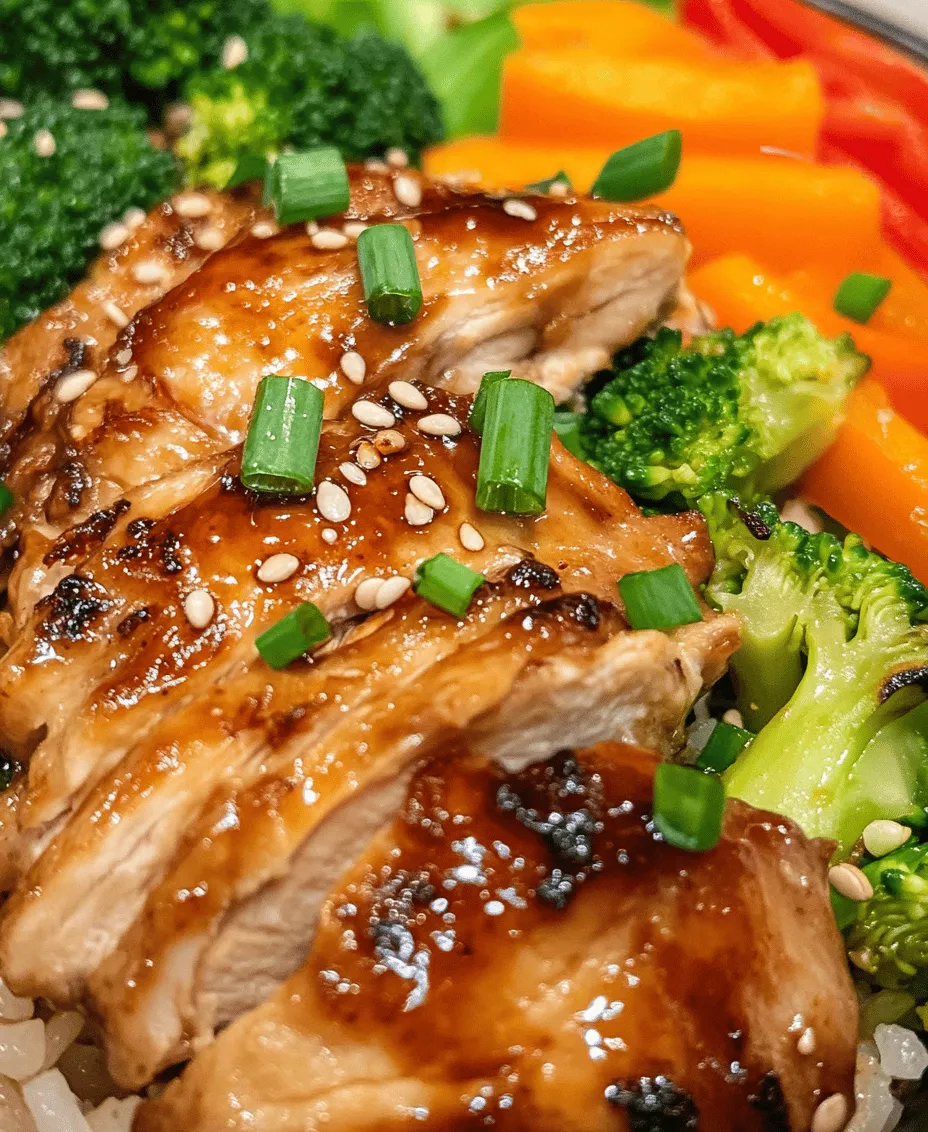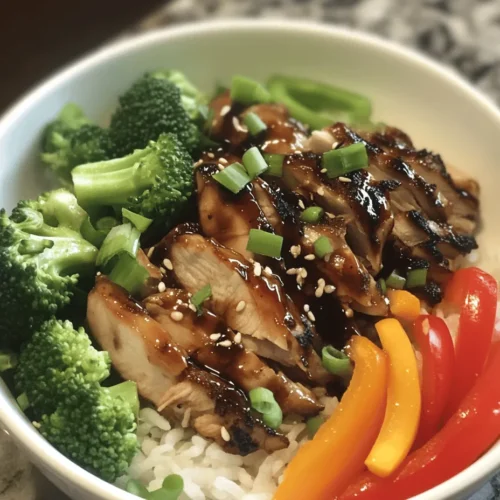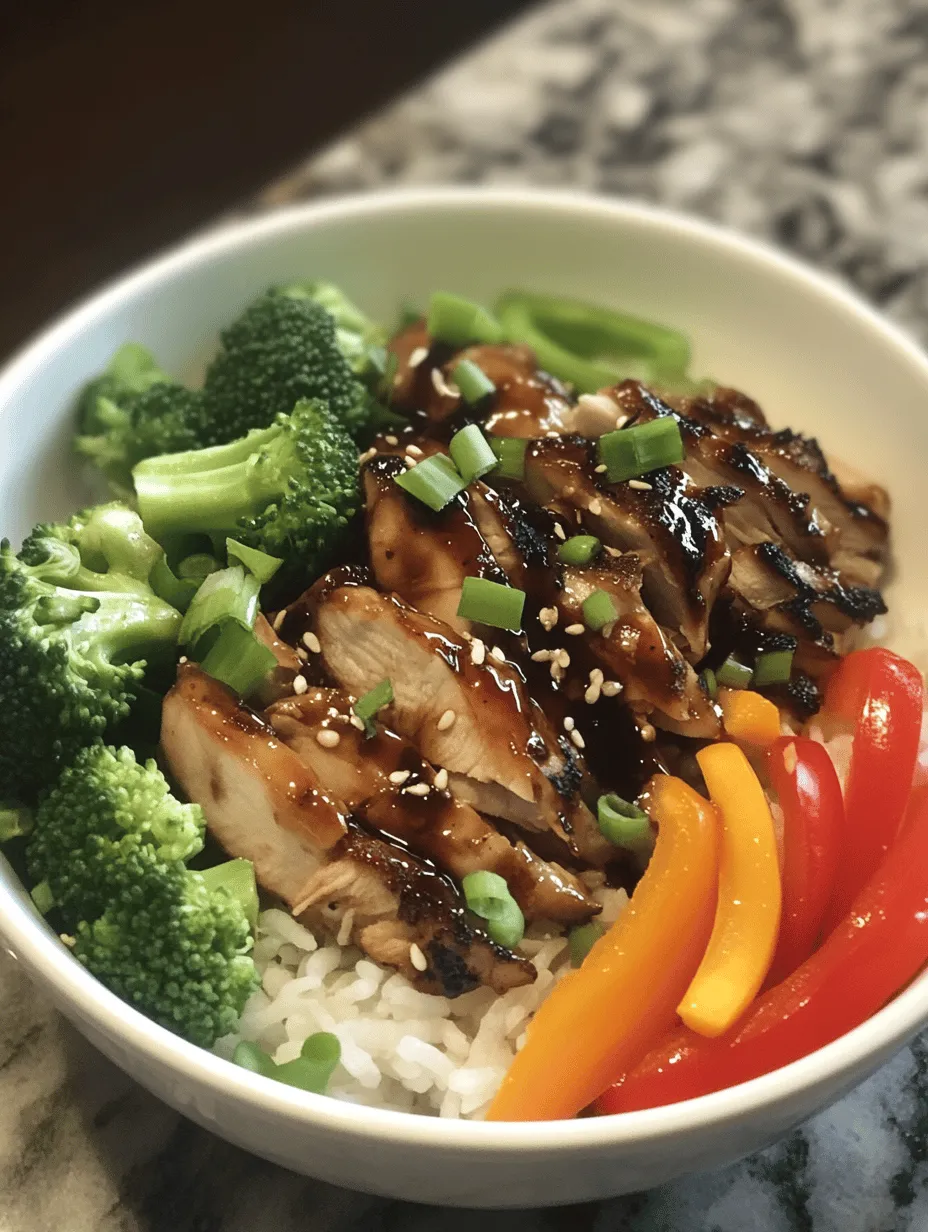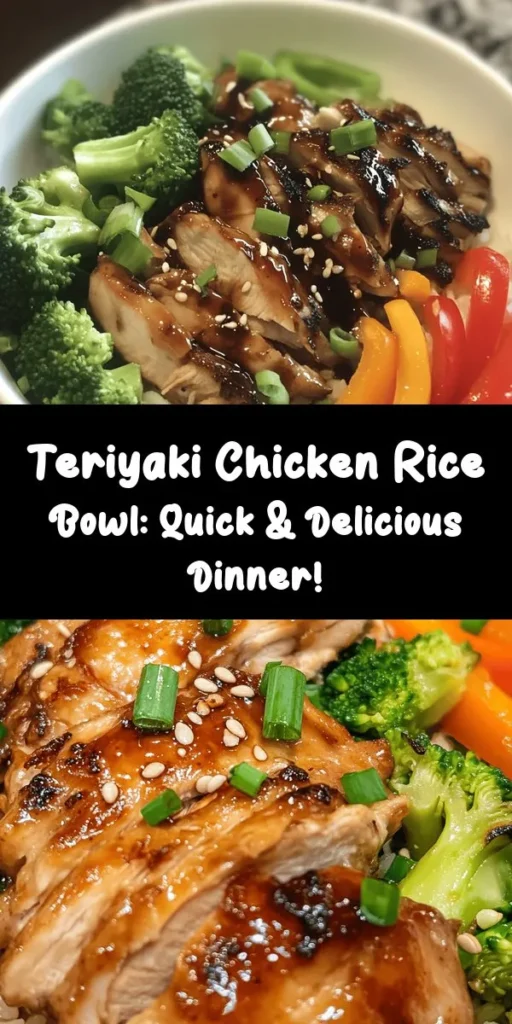Introduction
The Savory Teriyaki Chicken Rice Bowl is a delightful fusion of flavors that marries the succulence of chicken with the aromatic, sweet, and savory notes of teriyaki sauce. This dish has garnered a devoted following in homes and restaurants alike, becoming a staple in Japanese cuisine and beyond. Whether served as a quick weeknight dinner or as part of an elaborate meal, it consistently delivers comfort and satisfaction. The appeal of the teriyaki chicken rice bowl lies not only in its taste but also in its ability to provide a balanced meal that incorporates protein, carbohydrates, and an array of colorful vegetables.
In today’s fast-paced world, the importance of incorporating balanced meals into our everyday cooking cannot be overstated. With the right ingredients, you can whip up a nutritious meal that is both satisfying and packed with flavor. The harmony of tastes in a teriyaki chicken rice bowl offers an excellent way to introduce diverse flavors while ensuring that your meal is balanced and fulfilling.
This dish is defined by its unique combination of savory chicken, a glossy teriyaki glaze, fluffy jasmine rice, and fresh vegetables. Each ingredient plays a vital role in crafting a dish that is not only delicious but also visually appealing. The sweet and salty teriyaki sauce, made from soy sauce, mirin, and brown sugar, perfectly complements the tender chicken, while the vegetables add a pop of color and nutritional value.
Understanding Teriyaki Cuisine
To truly appreciate the Savory Teriyaki Chicken Rice Bowl, it’s essential to understand the historical background of teriyaki in Japanese cuisine. The term “teriyaki” is derived from the Japanese words “teri,” meaning glaze or shine, and “yaki,” meaning to grill or broil. This cooking technique has its roots in Japan, where it was first recorded in the Edo period (1603-1868). Traditionally, teriyaki was a method of grilling fish or meat, which was then brushed with a sweet soy-based sauce to enhance flavor and create a beautiful glaze.
Over time, teriyaki has evolved. Today, it encompasses a variety of proteins, including chicken, beef, and tofu, reflecting the versatility of the sauce and its adaptability to various cooking styles. The popularity of teriyaki has transcended cultural boundaries, leading to countless adaptations worldwide, each with its unique twist on the classic recipe.
Common ingredients used in teriyaki dishes include soy sauce, mirin (a sweet rice wine), sake, and sugar. Each of these components contributes to the signature flavor profile that teriyaki is known for. Soy sauce, with its umami richness, forms the base of the sauce, while mirin adds an essential sweetness and depth of flavor. The balance of sweetness and saltiness is key to achieving the perfect teriyaki sauce, and this balance can vary depending on regional tastes and personal preferences.
Variations of teriyaki sauce are plentiful and can include additional ingredients such as ginger, garlic, sesame oil, or even fruit juices to enhance the flavor. These variations can significantly influence the overall taste of the dish, allowing you to customize your teriyaki chicken rice bowl to suit your palate.
Ingredients Breakdown
The success of the Savory Teriyaki Chicken Rice Bowl lies in the quality and selection of its ingredients. Let’s take a closer look at each component that contributes to making this dish a standout.
Chicken
For this recipe, chicken thighs are the preferred choice. Compared to other cuts of meat, chicken thighs offer a richer flavor and juiciness, resulting in a more satisfying meal. The higher fat content in thighs ensures that the meat remains tender during cooking, making it perfect for absorbing the flavors of the teriyaki sauce. Furthermore, chicken is an excellent source of protein, essential for muscle repair and overall health.
Jasmine Rice
The choice of rice is crucial for achieving the perfect texture in your rice bowl. Jasmine rice is often recommended for teriyaki chicken rice bowls due to its fragrant aroma and slightly sticky texture, which helps it clump together nicely. This quality allows the rice to hold onto the teriyaki sauce, ensuring every bite is flavorful. Additionally, jasmine rice provides a good source of carbohydrates, giving you the energy needed for your day.
Teriyaki Sauce Ingredients
A homemade teriyaki sauce typically consists of three main components: soy sauce, mirin, and brown sugar.
– Soy Sauce: This key ingredient brings a savory umami flavor to the dish, serving as the backbone of the teriyaki sauce. It is essential to choose a high-quality soy sauce for the best results.
– Mirin: This sweet rice wine adds a layer of sweetness that balances the saltiness of the soy sauce. Its unique flavor also contributes to the glossy finish of the sauce.
– Brown Sugar: The addition of brown sugar enhances the sweetness of the sauce while giving it a rich depth of flavor. It caramelizes during cooking, creating a beautiful glaze on the chicken.
Vegetables
Incorporating vegetables into your teriyaki chicken rice bowl not only adds color and texture but also boosts the nutritional value of the meal. Commonly used vegetables include broccoli, bell peppers, and carrots:
– Broccoli: This nutrient-dense vegetable is packed with vitamins C and K, as well as fiber, making it an excellent addition to any meal.
– Bell Peppers: Available in various colors, bell peppers are rich in antioxidants and vitamins, particularly vitamin C. They add a refreshing crunch to the dish.
– Carrots: Carrots contribute natural sweetness and vibrant color, along with beta-carotene, which is beneficial for eye health.
Preparation Steps for the Perfect Teriyaki Chicken Rice Bowl
Preparing a Savory Teriyaki Chicken Rice Bowl involves several steps that ensure each component is cooked to perfection. Here’s a detailed guide to help you through the process.
Step 1: Cooking Jasmine Rice
To start, you’ll want to properly cook your jasmine rice. Rinse the rice under cold water until the water runs clear, which helps remove excess starch and prevents the rice from becoming gummy. Soaking the rice for about 30 minutes before cooking can further improve its texture.
Cooking Methods
When it comes to cooking jasmine rice, you have a couple of options. You can either use water or chicken broth for cooking. While water will yield a neutral flavor, using chicken broth adds an extra layer of richness to the rice, making it even more delicious.
1. Water Method: Use a ratio of 1 cup of jasmine rice to 1.5 cups of water. Bring the water to a boil, add the rice, reduce the heat to low, cover, and simmer for about 15-20 minutes or until the liquid is absorbed.
2. Chicken Broth Method: Use the same ratio as above but substitute chicken broth for water. Follow the same cooking instructions.
Step 2: Crafting the Ideal Teriyaki Sauce
While the rice is cooking, you can prepare the teriyaki sauce. In a small saucepan, combine the soy sauce, mirin, and brown sugar. Heat over medium heat, stirring until the sugar dissolves. To enhance the flavor, consider adding minced garlic or grated ginger to the sauce.
Remember to taste the sauce and adjust the sweetness or saltiness according to your preferences. If you find the sauce too sweet, add a dash of soy sauce to balance it out.
Step 3: Cooking Chicken
For the chicken, start by cutting the thighs into bite-sized pieces. This will ensure they cook evenly and absorb the teriyaki sauce beautifully.
In a skillet or wok, heat a splash of oil over medium-high heat. Add the chicken pieces and cook until they are browned and cooked through, which should take about 5-7 minutes.
Once cooked, pour the teriyaki sauce over the chicken and allow it to simmer for a few minutes. This step is crucial, as it allows the chicken to absorb the sauce’s flavors while also creating a tantalizing glaze.
Step 4: Sautéing the Vegetables
In the same skillet, you can quickly sauté the vegetables—broccoli, bell peppers, and carrots—until they are tender yet still crisp. This usually takes about 3-5 minutes. The vibrant colors of the vegetables not only enhance the dish visually but also add a range of nutrients to your meal.
By following these preparation steps, you’ll be well on your way to creating a Savory Teriyaki Chicken Rice Bowl that is sure to impress your family and friends. Stay tuned for the next part, where we will discuss serving suggestions and additional tips for making this dish your own.

Importance of Seasoning and Cooking Time
A successful Teriyaki Chicken Rice Bowl hinges on the balance of flavors and the precision of cooking time. Seasoning is critical; it enhances the natural taste of the chicken and vegetables while ensuring that each bite is flavorful. For our teriyaki sauce, a good blend of soy sauce, mirin, and sugar creates that signature sweet-savory profile. However, the key lies in not overwhelming your ingredients. Start with a measured amount of sauce—approximately 1/4 cup for 1 pound of chicken is generally a good ratio. You can always add more later, but it’s challenging to fix an overly salty dish.
When it comes to cooking time, chicken should reach an internal temperature of 165°F (74°C) to ensure it’s safe to eat. Use a meat thermometer for accuracy. Stir-frying the chicken over medium-high heat typically takes about 5-7 minutes, depending on the thickness of the pieces. The vegetables, on the other hand, should be cooked just enough to retain their vibrant colors and crunch, usually around 2-3 minutes. This careful attention to timing not only guarantees safety but also ensures that each ingredient shines in the dish.
Best Practices for Stir-Frying Vegetables to Maintain Crispness
To maintain the crispness of your vegetables while stir-frying, follow these best practices:
1. Prep Ahead: Cut all vegetables into uniform sizes to ensure even cooking. This helps them cook at the same rate, preventing some pieces from becoming mushy while others remain raw.
2. High Heat: Use a wok or a large skillet preheated on medium-high heat. The high temperature sears the vegetables quickly, locking in moisture and flavor while creating a slight char.
3. Don’t Overcrowd: Cook vegetables in batches if necessary. Overcrowding the pan can trap steam, resulting in soggy vegetables instead of the desired crispness.
4. Add in Stages: Start with denser vegetables like bell peppers and broccoli, which take longer to cook. Add quicker-cooking vegetables like snap peas or green beans last, ensuring they maintain their crunch.
Cooking Techniques and Tips
Understanding Heat Levels: When to Use Medium-High vs. Low Heat
Heat control is vital in stir-frying. Use medium-high heat for cooking the chicken and achieving a good sear, which locks in juices and flavors. Once the chicken is nearly cooked, reduce the heat to low when adding the teriyaki sauce. This prevents the sauce from burning and allows it to glaze the chicken evenly.
For vegetables, maintain medium-high heat to achieve that perfect quick sauté. This will give them a vibrant color and keep them crunchy.
Importance of Timing: How to Manage Cooking Chicken and Vegetables Simultaneously
Timing is essential in a stir-fry. Begin by cooking the chicken in a hot pan to get it started. Once the chicken pieces are about halfway cooked, add the denser vegetables. After a couple of minutes, incorporate the remaining vegetables, ensuring all components are ready to be tossed together at the end. If you prefer, you can also remove the chicken once cooked through, keep it warm, and then stir-fry the vegetables separately before combining everything with the teriyaki sauce.
Tips for Ensuring Even Cooking and Flavor Distribution
To ensure even cooking and flavor distribution, follow these tips:
1. Cut Uniformly: As mentioned, cutting all ingredients to similar sizes promotes even cooking.
2. Toss Frequently: Stir-frying requires constant motion. Use a spatula or wooden spoon to keep everything moving in the pan, ensuring all pieces come into contact with the hot surface.
3. Add Sauce Gradually: When adding your teriyaki sauce, do so in stages. This allows the sauce to coat the chicken and vegetables evenly without overwhelming the dish.
4. Let it Rest: Once cooked, let your stir-fry rest for a minute before serving. This allows the flavors to meld together.
Plating and Presentation
Ideas for Serving the Teriyaki Chicken Rice Bowl
Presentation can elevate your Teriyaki Chicken Rice Bowl from average to stunning. Start with a generous serving of steamed rice as the base. Arrange the chicken and vegetables artfully on top, creating a colorful display. Consider using a deep bowl to layer the ingredients, allowing the visual appeal to shine through.
Importance of Garnishing with Green Onions and Sesame Seeds
Garnishing plays a crucial role in the overall experience of your dish. Sliced green onions not only add a pop of color but also a fresh, oniony crunch that contrasts beautifully with the rich flavors of teriyaki. Toasted sesame seeds add a nutty flavor and a delightful crunch. A sprinkle of both garnishes just before serving enhances the dish’s visual appeal and flavor profile.
Suggestions for Complementary Side Dishes or Beverages
To round out your meal, consider pairing your Teriyaki Chicken Rice Bowl with complementary side dishes. Lightly pickled cucumbers or a simple seaweed salad can provide a refreshing contrast to the dish’s richness. For beverages, a cold glass of green tea or a light Japanese beer, like Asahi or Kirin, can cleanse the palate and enhance the dining experience.
Health and Nutritional Analysis
Breakdown of Calorie Content Per Serving
When prepared correctly, a serving of Teriyaki Chicken Rice Bowl typically contains around 450-600 calories, depending on the amount of rice and sauce used. This makes it a satisfying meal option that can fit into various dietary plans.
Analysis of Macronutrients: Proteins, Fats, and Carbohydrates
A well-balanced Teriyaki Chicken Rice Bowl provides a good source of macronutrients:
– Protein: The chicken provides a substantial amount of protein, essential for muscle repair and growth.
– Fats: If using skinless chicken breast and minimal oil for cooking, the fat content remains low. If you prefer a richer flavor, consider using chicken thighs, which contain more fat.
– Carbohydrates: The rice serves as the primary carbohydrate source, offering energy to fuel your day. If you’re looking for lower-carb options, consider substituting traditional rice with cauliflower rice or quinoa.
Discussion on How This Dish Fits Into a Balanced Diet
The Teriyaki Chicken Rice Bowl can easily fit into a balanced diet. It incorporates lean protein, healthy carbohydrates, and an array of vegetables, providing essential vitamins and minerals. Portion control and the choice of ingredients allow for a nutritious meal that satisfies without excessive calories.
Potential Modifications for Dietary Restrictions (Gluten-Free, Low-Carb, etc.)
For those with dietary restrictions, modifications are simple:
– Gluten-Free: Use gluten-free soy sauce or tamari instead of traditional soy sauce.
– Low-Carb: Substitute rice with cauliflower rice or spiralized zucchini to reduce carb intake.
– Dairy-Free: This recipe is naturally dairy-free, making it suitable for those with lactose intolerance.
Cultural Significance and Variations
How This Dish Represents a Fusion of Flavors Beyond Traditional Teriyaki
While teriyaki sauce has its roots in Japanese cuisine, the Teriyaki Chicken Rice Bowl showcases a fusion of flavors that reflects global culinary trends. The incorporation of various vegetables and the choice of rice type can take this dish beyond its traditional boundaries, allowing for personal expression and creativity in the kitchen.
Regional Variations in Teriyaki Dishes Around the World
Across the globe, teriyaki has been adapted to suit local tastes. In Hawaii, for instance, teriyaki chicken is often paired with sweet pineapple and served over rice, adding a tropical twist. In contrast, some Asian countries may include different spice blends or unique sides that complement the teriyaki flavor, showcasing the versatility of this beloved dish.
Personal Stories or Anecdotes About Enjoying Teriyaki Chicken Rice Bowls
Many food enthusiasts have fond memories associated with teriyaki chicken rice bowls. Some remember family dinners where they gathered around the table, savoring homemade versions. Others recount experiences at their favorite restaurants, where the aroma of grilled chicken and sizzling vegetables filled the air, creating an atmosphere of warmth and togetherness. These personal stories highlight how food transcends mere sustenance, creating connections and memories.
Conclusion
Creating a homemade Teriyaki Chicken Rice Bowl is not just about following a recipe; it’s about the joy of culinary exploration and the satisfaction of crafting a wholesome meal. This dish serves as a delightful fusion of flavors and textures, making it not only delicious but also a nourishing option for any meal. Whether enjoyed on a busy weeknight or as a hearty weekend treat, the Teriyaki Chicken Rice Bowl stands as a testament to the beauty of simple ingredients brought together with care.
Encourage yourself to explore this recipe and experiment with various flavors and ingredients. Cooking at home allows for creativity and personalization, transforming a simple dish into a beloved family favorite. So grab your ingredients, follow the steps, and enjoy the rewarding experience of making a Teriyaki Chicken Rice Bowl from scratch!



